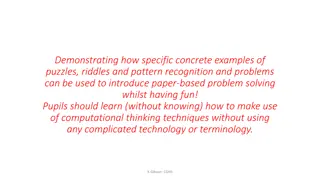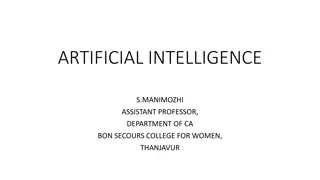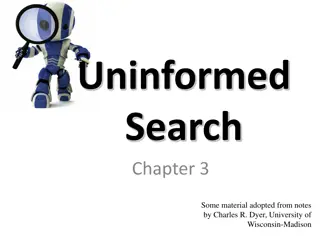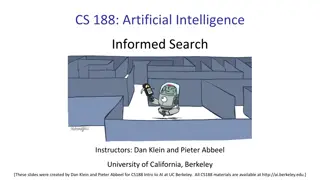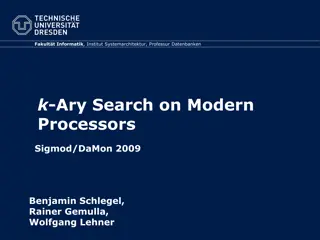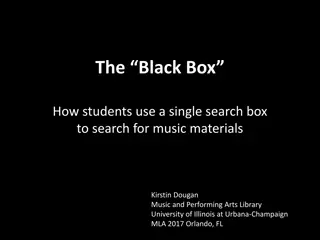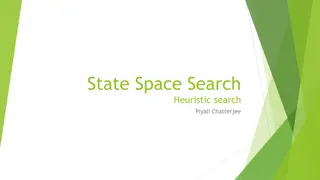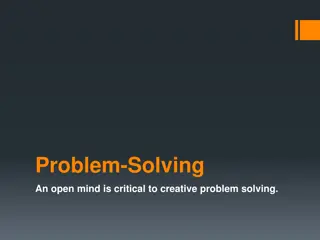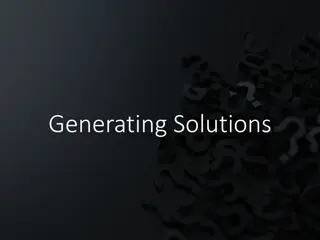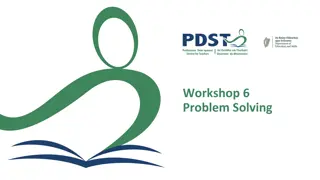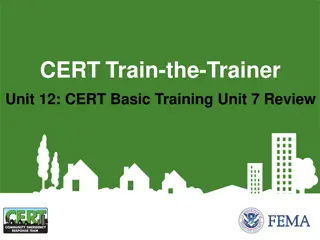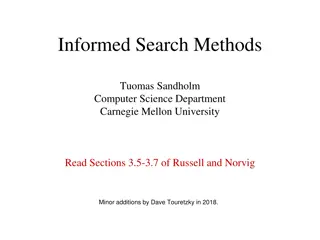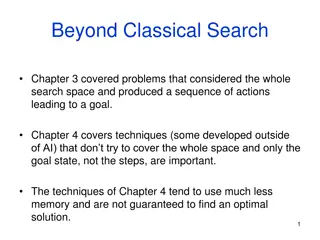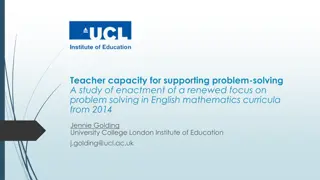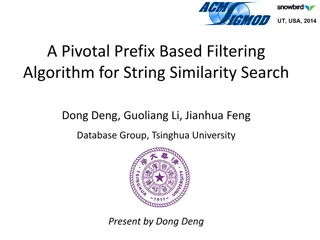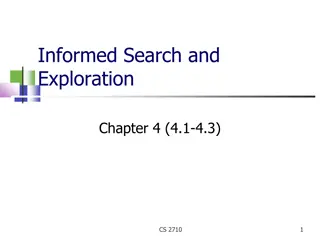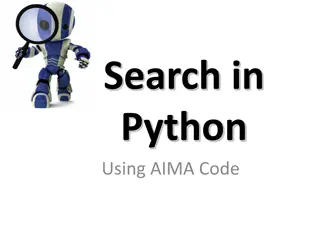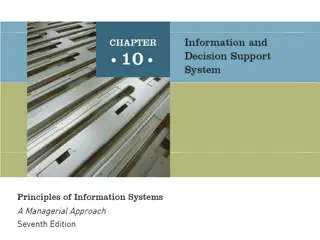
Artificial Intelligence Master Programmes in Europe
Explore the Master Programmes in Artificial Intelligence offered at the University of Cyprus. Delve into fundamentals and problem solving through search, learning algorithms, heuristics, and more. Gain insights into the intended learning outcomes and exams included in the curriculum.
Download Presentation

Please find below an Image/Link to download the presentation.
The content on the website is provided AS IS for your information and personal use only. It may not be sold, licensed, or shared on other websites without obtaining consent from the author. If you encounter any issues during the download, it is possible that the publisher has removed the file from their server.
You are allowed to download the files provided on this website for personal or commercial use, subject to the condition that they are used lawfully. All files are the property of their respective owners.
The content on the website is provided AS IS for your information and personal use only. It may not be sold, licensed, or shared on other websites without obtaining consent from the author.
E N D
Presentation Transcript
Master programmes in Artificial Intelligence 4 Careers in Europe University of Cyprus MAI611 Fundamentals of Artificial Intelligence Elpida Keravnou-Papailiou September December 2022 This Master is run under the context of Action No 2020-EU-IA-0087, co-financed by the EU CEF Telecom under GA nr. INEA/CEF/ICT/A2020/2267423
Master programmes in Artificial Intelligence 4 Careers in Europe Problem Solving through Search This Master is run under the context of Action No 2020-EU-IA-0087, co-financed by the EU CEF Telecom under GA nr. INEA/CEF/ICT/A2020/2267423
Master programmes in Artificial Intelligence 4 Careers in Europe UNIT 2 Problem Solving through Search CONTENTS 1. Algorithms and Heuristics 2. Representation Problem 3. Depth-First and Breadth-First Search Methods Blind Methods 4. Heuristic Search Algorithm A* and its variants Branch-and-Bound and Best-First Search Methods 5. Generic, Object-Based Search Method 6. Frame Problem 7. Classification and Synthesis Problems This Master is run under the context of Action No 2020-EU-IA-0087, co-financed by the EU CEF Telecom under GA nr. INEA/CEF/ICT/A2020/2267423 3
Master programmes in Artificial Intelligence 4 Careers in Europe INTENDED LEARNING OUTCOMES Upon completion of this unit on problem solving through search, students will be able: 1. To explain in general terms what a heuristic is and how heuristics could enhance purely algorithmic methods. 2. To explain how a problem is represented to be solved through search, that is, explain what the representation problem is. 3. To give and explain the algorithms for the "blind" methods, depth-first search, otherwise gullible search, and breadth-first search, otherwise skeptical search, and to explain the notions of combinatorial explosion, branching factor, admissibility and efficiency. 4. To give and explain the algorithm A* for search with heuristic guidance, and its variants branch-and-bound and best-first search. 5. To be able to design and implement an object-based generic search method and to extend it for solving a specific problem by search. 6. To explain at a high level what the frame problem is. 7. To be able to differentiate classification problems from synthesis problems. This Master is run under the context of Action No 2020-EU-IA-0087, co-financed by the EU CEF Telecom under GA nr. INEA/CEF/ICT/A2020/2267423 4
Master programmes in Artificial Intelligence 4 Careers in Europe Algorithms and Heuristics This Master is run under the context of Action No 2020-EU-IA-0087, co-financed by the EU CEF Telecom under GA nr. INEA/CEF/ICT/A2020/2267423
Master programmes in Artificial Intelligence 4 Careers in Europe Example Which route to follow to go from some town X to some town Y, using a road map giving the direct connections between towns? Algorithmic Solution: Use the shortest path A purely algorithmic method is a step-by-step method that takes the problem input and computes the requested solution. A heuristic method deploys heuristics This Master is run under the context of Action No 2020-EU-IA-0087, co-financed by the EU CEF Telecom under GA nr. INEA/CEF/ICT/A2020/2267423 6
Master programmes in Artificial Intelligence 4 Careers in Europe Heuristics Heuristics are rules of thumb, rules of good guessing; they are problem specific They do not guarantee success, hence they are not infallible, but they provide useful guidance in most cases of the problem, leading to satisfactory, or even optimal solutions, in a computationally effective/viable way. They do not negate the basic algorithmic approach in problem solving, in other words the step-by-step search for some solution but augment them, bestowing them intelligence . This Master is run under the context of Action No 2020-EU-IA-0087, co-financed by the EU CEF Telecom under GA nr. INEA/CEF/ICT/A2020/2267423 7
Master programmes in Artificial Intelligence 4 Careers in Europe Example heuristics for the route problem Rule 1: If the start is town-S and the destination is town-D and the day is Tuesday, do not consider routes through town- D M S pruning heuristic Rule 2: If the start is town- and the destination is town-D, use the route town- , town-B, town-C, town-D B D C A homing heuristic This Master is run under the context of Action No 2020-EU-IA-0087, co-financed by the EU CEF Telecom under GA nr. INEA/CEF/ICT/A2020/2267423 8
Master programmes in Artificial Intelligence 4 Careers in Europe Highlights The rationale behind the given heuristics is not explicated These heuristics are very specific as they refer to actual towns by name A plethora of such very specific heuristics could surpass their utility This Master is run under the context of Action No 2020-EU-IA-0087, co-financed by the EU CEF Telecom under GA nr. INEA/CEF/ICT/A2020/2267423 9
Master programmes in Artificial Intelligence 4 Careers in Europe Generalizing heuristic rule 1 If the passage through the CITY is not necessary and there is a high probability that there will be crowding there on the day of the passage, then block the CITY Symbol CITY denotes any town, i.e., it is a variable and not a literal name This Master is run under the context of Action No 2020-EU-IA-0087, co-financed by the EU CEF Telecom under GA nr. INEA/CEF/ICT/A2020/2267423 10
Master programmes in Artificial Intelligence 4 Careers in Europe Generalizing heuristic rule 1, gives rise to concepts necessary passage and crowding , that could also be denoted through symbolic rules as follows: If the CITY is the start or the destination, the passage through it is necessary If there is a public market going on, there is a high possibility of crowding If there is a road accident, there is a high possibility of crowding This Master is run under the context of Action No 2020-EU-IA-0087, co-financed by the EU CEF Telecom under GA nr. INEA/CEF/ICT/A2020/2267423 11
Master programmes in Artificial Intelligence 4 Careers in Europe Representation Problem This Master is run under the context of Action No 2020-EU-IA-0087, co-financed by the EU CEF Telecom under GA nr. INEA/CEF/ICT/A2020/2267423
Master programmes in Artificial Intelligence 4 Careers in Europe Solving a problem by search 1. Representation of the states of the problem; all possible states (problem instances) constitute the state space 2. Identification of actions (or action operators) leading from one state to another 3. Identification of the navigation mechanism in the state space This Master is run under the context of Action No 2020-EU-IA-0087, co-financed by the EU CEF Telecom under GA nr. INEA/CEF/ICT/A2020/2267423 13
Master programmes in Artificial Intelligence 4 Careers in Europe Representation Problem This is a meta-problem It entails the representation of an (object) problem in a way that it can be solved by search A key issue is deciding the representation of the (object) problem states, which could be straightforward if there is only one choice, or not if there are alternative representation choices The state transition operators and overall state space depend on the problem state representation A problem state representation yielding a smaller state space is preferrable This Master is run under the context of Action No 2020-EU-IA-0087, co-financed by the EU CEF Telecom under GA nr. INEA/CEF/ICT/A2020/2267423 14
Master programmes in Artificial Intelligence 4 Careers in Europe Representation problem for an object problem Specify state space this constitutes the space in which the search takes place - search space Structure for problem states symbol structure Operators for converting one state to another state Initial and final/goal states Specify navigation/search method in the search space Blind , systematic navigation Guided navigation define heuristics This Master is run under the context of Action No 2020-EU-IA-0087, co-financed by the EU CEF Telecom under GA nr. INEA/CEF/ICT/A2020/2267423 15
Master programmes in Artificial Intelligence 4 Careers in Europe Example: Representing the search space for a problem that involves playing a board game (chess, checkers, backgammon, etc.) State space: State structure: Initial state: Final stares: Action operators: permitted board cconfigurations two-dimensional table initial board configuration the ones that represent win for one or the other opponent the rules of the game The great difficulty of the representation problem for such (object) problems is the identification of powerful heuristics, which can turn the computer into a powerful opponent. This Master is run under the context of Action No 2020-EU-IA-0087, co-financed by the EU CEF Telecom under GA nr. INEA/CEF/ICT/A2020/2267423 16
Master programmes in Artificial Intelligence 4 Careers in Europe How big is a state space? Chess: After both players move, 400 possible board setups exist. After the second pair of turns, there are 197,742 possible games, and after three moves, 121 million. Go: The state space is vast; the number of states is greater than the number of atoms in the universe! Tic-tac-toe: The upper bound for the state space is 39= 19,683; there are three situations for each cell and nine cells. This count includes many illegal positions, such as a position with five crosses and no noughts, or a position in which both players have a row of three. 8-puzzle: The state space is 9! = 362,880 Jugs problem: The state space is (m+1)(n+1) where m and n are the respective capacities of the two jugs. Brute force search methods are not viable in huge state spaces Only part of a state space is explicated depending on the search method, and the power of the heuristics used search tree This Master is run under the context of Action No 2020-EU-IA-0087, co-financed by the EU CEF Telecom under GA nr. INEA/CEF/ICT/A2020/2267423 17
State Space Generally, it is a graph Multiple ways to reach a state Nodes are states of the problem initial, intermediate and final states for specific instances of the problem, the initial state is given and possibly the final state(s) goal state(s) The arcs represent actions This Master is run under the context of Action No 2020-EU-IA-0087, co-financed by the EU CEF Telecom under GA nr. INEA/CEF/ICT/A2020/2267423
Master programmes in Artificial Intelligence 4 Careers in Europe Final States In many problems the final states cannot be specified in advance, or it is not appropriate to do so. The essence of the problem may be the recognition of the final state. If the final state can be fully defined in advance, the solution to the problem is to assemble a satisfactorily good path from the initial to the final state. Objective To reach a (satisfactory) final state through a satisfactory route The solution is either the final state itself, the route itself, or both This Master is run under the context of Action No 2020-EU-IA-0087, co-financed by the EU CEF Telecom under GA nr. INEA/CEF/ICT/A2020/2267423 19
Master programmes in Artificial Intelligence 4 Careers in Europe Navigation/Search Method Operators premise action To start with the initial state is defined, as well as the final state(s) if known The premise specifies a condition that must be satisfied by a state as a prerequisite for applying the action to the state Which part of the state space is subsequently explicated depends on the navigation method, based on which operators are selected and applied to the open states The application of the action to the state leads to a new (successor) state Actions are summative (they only add elements to obtain new states) or are mutative (they could add and/or remove elements to obtain new states) The part of the state space explicated forms a search tree where each node has one parent as we only need to remember the best way so far found of reaching any state This Master is run under the context of Action No 2020-EU-IA-0087, co-financed by the EU CEF Telecom under GA nr. INEA/CEF/ICT/A2020/2267423 20
Master programmes in Artificial Intelligence 4 Careers in Europe Combinatorial Explosion uniform branching factor b = 2; n = 4 The search tree grows explosively with increasing depth A branching factor of b (average number of successors per search node) would give a search tree with bnleaf nodes, when the search goes to depth n In chess: b averages around 30 for a complete game, n will be around 100 Thus, exploring the whole tree will produce30100 or around 10145nodes, which is considerably more than the number of atoms in the universe This Master is run under the context of Action No 2020-EU-IA-0087, co-financed by the EU CEF Telecom under GA nr. INEA/CEF/ICT/A2020/2267423 21
Master programmes in Artificial Intelligence 4 Careers in Europe Admissible Search Method Guaranteed to find the best solution, if one exists Theoretical property of the method Efficiency of Search Method How much effort is expended in finding a solution Efficiency = (number of nodes on solution path)/(number of nodes visited) Empirically measured for every instance of the search method performed Get the average over a representative set of trials of the given problem An optimal search method would visit only the nodes which turn out to be on the solution path, yielding an efficiency of 1.0 This Master is run under the context of Action No 2020-EU-IA-0087, co-financed by the EU CEF Telecom under GA nr. INEA/CEF/ICT/A2020/2267423 22
Master programmes in Artificial Intelligence 4 Careers in Europe Heuristics, efficiency and computational overhead top efficiency; search tree is the solution path (low memory demand and low time in expanding nodes visited) low efficiency; search tree explicates a large part of the state space (high memory demand and high time in expanding nodes visited) This Master is run under the context of Action No 2020-EU-IA-0087, co-financed by the EU CEF Telecom under GA nr. INEA/CEF/ICT/A2020/2267423 23
Master programmes in Artificial Intelligence 4 Careers in Europe Heuristics, efficiency and computational overhead Heuristic deployment needs to strike a balance between the quality of guidance and the computational overhead associated with their use High computational overhead defeats the purpose of using heuristics It could enhance the efficiency of search but at a high computational cost Efficiency reflects how targeted the search is towards the problem goal Could be more beneficial to have a higher number of visited nodes, in conjunction with the use of less effective heuristics, if the overall time in obtaining a problem solution is comparatively lower than when using highly effective heuristics This Master is run under the context of Action No 2020-EU-IA-0087, co-financed by the EU CEF Telecom under GA nr. INEA/CEF/ICT/A2020/2267423 24
Master programmes in Artificial Intelligence 4 Careers in Europe General Search Methods Depth-First search Breadth-First search Heuristic search A* Best-first search greedy search Branch-and-Bound search The minimum requirement is to avoid circular paths, as these lead to infinite search loops There should be progress towards the sought solution This Master is run under the context of Action No 2020-EU-IA-0087, co-financed by the EU CEF Telecom under GA nr. INEA/CEF/ICT/A2020/2267423 25
Master programmes in Artificial Intelligence 4 Careers in Europe Definitions Open search node: non final state which has not been explored yet, or its re-exploring is indicated Closed search node: a state that has been explored and presently it is of that status Parent of search node s: a search node, s , leading directly, i.e., through the application of a single action, to search node s and at present the route from the initial search node to s, through s is considered so far, the best Successors of search node s: search nodes for which s is (presently) their parent; these could be a subset of the set of states descending directly from s through applicable actions (direct descenders of s which are not vetted as successors of s have other parents) Deadlock: a non final state that has no successors, or all its successors lead to deadlock This Master is run under the context of Action No 2020-EU-IA-0087, co-financed by the EU CEF Telecom under GA nr. INEA/CEF/ICT/A2020/2267423 26
Master programmes in Artificial Intelligence 4 Careers in Europe Search Assumptions The navigation starts from the initial problem state (the root node of the search tree) towards a (good enough and not necessarily optimal, if this is not predefined) final state (a leaf node of the search tree), piecing together a good enough route from the root node to the final leaf-node Initially there is only one open search node (giving the initial problem state) and there are no closed search nodes This Master is run under the context of Action No 2020-EU-IA-0087, co-financed by the EU CEF Telecom under GA nr. INEA/CEF/ICT/A2020/2267423 27
Master programmes in Artificial Intelligence 4 Careers in Europe Depth-First and Breadth-First Search Methods This Master is run under the context of Action No 2020-EU-IA-0087, co-financed by the EU CEF Telecom under GA nr. INEA/CEF/ICT/A2020/2267423
Master programmes in Artificial Intelligence 4 Careers in Europe Depth-First Search Attempts to quickly penetrate deep into the state space It can reach a final state in an effective way Its memory requirement is not excessive However, it can get lost in the state space, or reach a deadlock And it does not necessarily find an optimal solution - not admissible Gullible method: It assumes that a deep-down search node is nearest to a goal state This Master is run under the context of Action No 2020-EU-IA-0087, co-financed by the EU CEF Telecom under GA nr. INEA/CEF/ICT/A2020/2267423 29
Master programmes in Artificial Intelligence 4 Careers in Europe Backtracking when deadlock is reached, or the maximum path length is exceeded Revoking the last action choice The search goes back one step on the path under investigation (parent search node) and a new choice is made When all possible choices from the (parent) search node have been investigated, the backtracking continues with the immediately above search node (parent of the parent), etc. If the backtracking leads to the root search node (initial state) the entire search so far has been fruitless This Master is run under the context of Action No 2020-EU-IA-0087, co-financed by the EU CEF Telecom under GA nr. INEA/CEF/ICT/A2020/2267423 30
Depth-First Search S1 S3 S2 S4 S5 S6 S7 This Master is run under the context of Action No 2020-EU-IA-0087, co-financed by the EU CEF Telecom under GA nr. INEA/CEF/ICT/A2020/2267423
Master programmes in Artificial Intelligence 4 Careers in Europe Breadth-First Search It is possessed by excessive skepticism All routes of length N are thoroughly investigated, before a route of length N+1 is investigated, starting from routes of length 1 It leads to an optimal solution, where optimal means at the shortest distance from the initial state The admissibility of the breadth-first search method is easily proven Assume that the method finds a solution at depth N, but there is also a solution at depth M where M < N. But all routes at depth M have been thoroughly investigated before moving deeper to depth N Hence if a solution existed at depth M, it would have been discovered This Master is run under the context of Action No 2020-EU-IA-0087, co-financed by the EU CEF Telecom under GA nr. INEA/CEF/ICT/A2020/2267423 32
Master programmes in Artificial Intelligence 4 Careers in Europe Limitations of Breadth-First Search It leads to combinatorial explosion, with exponential demands both in memory space and computational time Hence it cannot be realistically applied to large state spaces This Master is run under the context of Action No 2020-EU-IA-0087, co-financed by the EU CEF Telecom under GA nr. INEA/CEF/ICT/A2020/2267423 33
Breadth-First Search S1 S3 S2 S4 S5 S6 S7 This Master is run under the context of Action No 2020-EU-IA-0087, co-financed by the EU CEF Telecom under GA nr. INEA/CEF/ICT/A2020/2267423
Algorithm for Depth-First Search 1. OPEN := [ so] , CLOSED := [ ] 2. If OPEN = [ ] terminate the search. There is no solution. 3. Remove the first search node, si, from OPEN and add to CLOSED. -35 4.Based on the actions that can be applied to sicompute the successors of si, that are not already included in OPEN or CLOSED. Every successor node specifies sias its parent node. 5. If a successor node of si, say sg, refers to the goal state, terminate the search and return as solution the route from so to sg. Otherwise add the successors at the start of list OPEN and repeat from step 2. It is noted that list OPEN is treated as a stack This Master is run under the context of Action No 2020-EU-IA-0087, co-financed by the EU CEF Telecom under GA nr. INEA/CEF/ICT/A2020/2267423
Algorithm for Breadth-First Search 1. OPEN := [ so] , CLOSED := [ ] 2. If OPEN = [ ] terminate the search. There is no solution. 3. Remove the first search node, si, from OPEN and add to CLOSED. -36 4.Based on the actions that can be applied to sicompute the successors of si, that are not already included in OPEN or CLOSED. Every successor node specifies sias its parent node. 5. If a successor node of si, say sg, refers to the goal state, terminate the search and return as solution the route from so to sg. Otherwise add the successors at the end of list OPEN and repeat from step 2. It is noted that list OPEN is treated as a queue This Master is run under the context of Action No 2020-EU-IA-0087, co-financed by the EU CEF Telecom under GA nr. INEA/CEF/ICT/A2020/2267423
Master programmes in Artificial Intelligence 4 Careers in Europe Depth-First and Breadth-First: How do they differ? In depth-first the list of OPEN search nodes is a stack, while in breadth-first it is a queue Hence in depth-first, a successor of the last search node explored, is the next search node to be explored, while in breadth-first the successors of the last search node explored will be explored once all search nodes, already in the OPEN list, are explored This difference results in the breadth-first search being unduly skeptical (nothing is overlooked) and in the depth-first search being unduly gullible (forcefully pursuing a single path until it succeeds or fails) This Master is run under the context of Action No 2020-EU-IA-0087, co-financed by the EU CEF Telecom under GA nr. INEA/CEF/ICT/A2020/2267423 37
Master programmes in Artificial Intelligence 4 Careers in Europe Search trees and exploring open search nodes At any time, before a goal state is reached, a search tree includes several paths: Paths ending at CLOSED search nodes are not under consideration If all paths are of this category, there is no solution Paths ending at OPEN search nodes can be potentially expanded further In depth-first and breadth-first, the successors of an OPEN search node are ordered in a pre-determined way, depending on the order of the (applicable) actions Why search nodes already OPEN or CLOSED are not included in the successors of the currently explored search node? This Master is run under the context of Action No 2020-EU-IA-0087, co-financed by the EU CEF Telecom under GA nr. INEA/CEF/ICT/A2020/2267423 38
Master programmes in Artificial Intelligence 4 Careers in Europe Why in depth-first and breadth-first, search nodes already OPEN or CLOSED are not included in the successors of the currently explored search node? Recall that at any time, the search tree keeps the best path so far from the root node to some search node Breadth-first: if a successor, s, of the currently explored search node, p, is already OPEN or CLOSED, a new path from the root node to s via p is found. Is this new path better, i.e., shorter, than the presently kept path from the root to s? If the length of the present path is N and of the new path is M, could M < N? This is not possible as all paths of length smaller than N would have been investigated prior to investigating paths of length N. Depth-first: If the currently explored search node, p, is at depth N from the root node, no other OPEN search node is at a bigger depth. If a successor, s, of p is already OPEN at depth M, it follows that M N, and hence the new path to s via p, is worse as it has length N+1. If s is CLOSED, it is either on an abandoned path, or on the pursued path from the root to p, hence re-OPENing it with p as its parent would create a circular path. This Master is run under the context of Action No 2020-EU-IA-0087, co-financed by the EU CEF Telecom under GA nr. INEA/CEF/ICT/A2020/2267423 39
Example: 8-puzzle In the 8-puzzle game, eight tiles numbered from 1 to 8 are placed in a 3 3 board. Hence there is always a blank space. The rules of the game allow the sliding of tiles one place up, down, left, or right, into the blank space. The problem is to determine a sequence of sliding moves for converting a given initial configuration of the eight tiles (initial state), into some other given configuration (final or goal state). An instance of the problem is shown below: -40 1 7 4 2 3 5 3 6 6 7 5 8 2 4 8 1 initial state final state This Master is run under the context of Action No 2020-EU-IA-0087, co-financed by the EU CEF Telecom under GA nr. INEA/CEF/ICT/A2020/2267423
Master programmes in Artificial Intelligence 4 Careers in Europe Solving the representation problem for the 8-puzzle Define a structure for the problem states 3 3 array of integers 0 represents the blank space Define the operators (which are listed and evaluated in some order) If tile 1 is above the blank space, slide it down into the blank space If tile 1 is on the left of the blank space, slide it right into the blank space If tile 1 is on the right of the blank space, slide it left into the blank space If tile 1 is below the blank space, slide it up into the blank space . . . . . . If tile 8 is above the blank space, slide it down into the blank space If tile 8 is on the left of the blank space, slide it right into the blank space If tile 8 is on the right of the blank space, slide it left into the blank space If tile 8 is below the blank space, slide it up into the blank space The problem state structure and the operators define the state space Choose the search method Is it a good representation to have 32 very specific operators? This Master is run under the context of Action No 2020-EU-IA-0087, co-financed by the EU CEF Telecom under GA nr. INEA/CEF/ICT/A2020/2267423 41
Master programmes in Artificial Intelligence 4 Careers in Europe Solving the representation problem for the 8-puzzle Define a structure for the problem states 3 3 array of integers 0 represents the blank space Define the operators (which are listed and evaluated in some order) U: If there is a tile <T> above the blank space, slide tile <T> down into the blank space D: If there is a tile <T> below the blank space, slide tile <T> up into the blank space L: If there is a tile <T> on the left of the blank space, slide tile <T> right into the blank space R: If there is a tile <T> on the right of the blank space, slide tile <T> left into the blank space Only 4 general rules focusing on the position of the blank space: <T> is a variable denoting any tile, that is appropriately instantiated when operators are applied The problem state structure and the operators define the state space Choose the search method Depth-first or breadth-first In either method the operators are ordered as U, D, L, R This Master is run under the context of Action No 2020-EU-IA-0087, co-financed by the EU CEF Telecom under GA nr. INEA/CEF/ICT/A2020/2267423 42
1 7 4 6 3 5 8 2 U R D 7 4 1 7 4 1 7 4 1 6 3 5 6 3 6 3 5 8 R 2 8 2 5 8 2 Depth-First Search 7 4 1 6 3 5 8 2 D R 7 6 4 7 4 1 3 1 6 3 5 8 2 5 8 2 R D L 7 6 4 7 6 4 7 6 4 1 8 3 1 3 1 3 5 2 5 8 2 5 8 2 This Master is run under the context of Action No 2020-EU-IA-0087, co-financed by the EU CEF Telecom under GA nr. INEA/CEF/ICT/A2020/2267423 R L
1 7 4 6 3 5 8 2 U R D 7 4 1 7 4 1 7 4 1 6 3 5 6 3 6 3 5 8 2 8 U 2 5 8 2 R R D R 7 4 1 7 4 1 4 1 7 4 1 7 4 1 6 3 5 6 3 6 7 3 6 8 3 6 3 5 8 2 8 2 5 8 2 5 2 5 8 2 D L L R U R R R U D Breadth-First Search This Master is run under the context of Action No 2020-EU-IA-0087, co-financed by the EU CEF Telecom under GA nr. INEA/CEF/ICT/A2020/2267423
Some instances of the 8-puzzle cannot be solved A pair of tiles in the initial state form an inversion if the values on the tiles are in reverse order of their appearance in the goal state. If the number of inversions is even the given instance of the 8-puzzle is solvable. 8 2 1 1 2 3 1, 8, 2, 4, 3, 7, 6, 5 initial state flattening 1, 2, 3, 4, 5, 6, 7, 8 goal state flattening 4 3 5 6 4 7 6 5 7 8 Inversions (8,2) (8,4) (8,3) (8,7) (8,6) (8,5) (4,3) (7,6) (7,5) (6,5) solvable 10 inversions This Master is run under the context of Action No 2020-EU-IA-0087, co-financed by the EU CEF Telecom under GA nr. INEA/CEF/ICT/A2020/2267423
Some instances of the 8-puzzle cannot be solved A pair of tiles in the initial state form an inversion if the values on the tiles are in reverse order of their appearance in the goal state. If the number of inversions is odd the given instance of the 8-puzzle cannot be solved. 1 2 8 1 2 3 8, 1, 2, 4, 3, 7, 6, 5 initial state flattening 1, 2, 3, 4, 5, 6, 7, 8 goal state flattening 4 3 5 6 4 7 6 5 7 8 Inversions (8,1) (8,2) (8,4) (8,3) (8,7) (8,6) (8,5) (4,3) (7,6) (7,5) (6,5) not solvable 11 inversions This Master is run under the context of Action No 2020-EU-IA-0087, co-financed by the EU CEF Telecom under GA nr. INEA/CEF/ICT/A2020/2267423
Master programmes in Artificial Intelligence 4 Careers in Europe Heuristic Search Algorithm A* and its variants Branch- and-Bound and Best-First Search Methods This Master is run under the context of Action No 2020-EU-IA-0087, co-financed by the EU CEF Telecom under GA nr. INEA/CEF/ICT/A2020/2267423
Master programmes in Artificial Intelligence 4 Careers in Europe Heuristic Search Aims to combine the strengths of the depth-first and breadth-first methods and to alleviate their serious weaknesses The OPEN search nodes are evaluated and every time the search node investigated is the one that appears to be the most promising, i.e., the one that appears to be on the best path towards the solution Balances depth and breadth of search through heuristic guidance Avoid getting into fruitless depth Avoid combinatorial explosion How are OPEN search nodes evaluated? This Master is run under the context of Action No 2020-EU-IA-0087, co-financed by the EU CEF Telecom under GA nr. INEA/CEF/ICT/A2020/2267423 48
Search Node Evaluation So Si Sg g(Si) h(Si) f(Si) The evaluation function, f, is defined as: f (Si) = = g(Si) + h(Si) This Master is run under the context of Action No 2020-EU-IA-0087, co-financed by the EU CEF Telecom under GA nr. INEA/CEF/ICT/A2020/2267423
Master programmes in Artificial Intelligence 4 Careers in Europe Search Node Evaluation Function g gives the real transition cost from soto si: Every operator has a cost this could be a unit cost for all operators Since the best path so far from soto siis known, the real cost is known g(so) = 0 The heuristic function, h, guesses the transition cost from sito sg: Hence, function h says how promising the problem state represented by search node siis, i.e., how appropriate it would be to search for a solution through si The reliability of the evaluation function f depends on the reliability of the heuristic function h If h overestimates the cost, there is a risk to ignore si However, if the cost is underestimated, there is a risk to get jammed into a fruitless search h(sg) = 0 This Master is run under the context of Action No 2020-EU-IA-0087, co-financed by the EU CEF Telecom under GA nr. INEA/CEF/ICT/A2020/2267423 50

